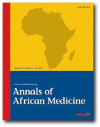
|
Annals of African Medicine
Annals of African Medicine Society
ISSN: 1596-3519
Vol. 5, No. 1, 2006, pp. 42-45
|
 Bioline Code: am06010
Bioline Code: am06010
Full paper language: English
Document type: Research Article
Document available free of charge
|
|
|
Annals of African Medicine, Vol. 5, No. 1, 2006, pp. 42-45
| fr |
Eke, R. A.; Chigbu, L. N. & Nwachukwu, W.
Résumé
Fond:
Le paludisme est endémique dans beaucoup de régions du monde. De diverses stratégies ont été projetées pour lutter contre le paludisme de temps en temps dans beaucoup de régions. Quelle que soit la stratégie, la prévalence du parasitémie symptomatique et asymptomatique de plasmodium a été d'importance primordiale en tant que paramètre utile pour sa commande. On l'espère que le programme de lutte contre le paludisme au Nigéria tirera bénéfice de la prédominance de l'étude parasitémique de ce type.
Méthode :
Ndiegoro, une zone de désastre d'inondation, a été choisi par l'échantillonage aléatoirement stratifié à partir de 16 zones de division municipale 3 sur 12 divisions municipales du gouvernement municipal de Sud Aba. Il y a 2 gouvernements municipaux dans la ville d'Aba. Environ trois quarts des maisons étaient inhabités car ils ont été submergés à de diverses profondeurs de la zone choisie. La population qui a consenti pour l'étude était 257 personnes. Des frottis sanguins épais et minces ont été étudiés par photomicroscopie pour la parasitémie de plasmodium.
Résultats:
La prévalence du parasitémie de plasmodium dans la population étudiée de 257 était très haute (45,1%). Le parasitémies asymptomatiques étaient environ trois fois autant que parasitémie symptomatique (73,2% et 26,7% respectivement). Cette différence est statistiquement significative (p<.01). La catégorie d'âge 0-4 ans a donné la moindre distribution de la parasitémie asymptomatique du paludisme de 2(2,9%) et d'une parasitémie symptomatique très haut de 16 (88,8%). La catégorie d'âge supérieure de 40-59 a statistiquement la différence significative (p < 0,01) dans la distribution de la parasitémie asymptomatique de 51 (43,6%) dans les mâles par comparaison avec 34 (24,3%) dans les femelles.
Conclusion:
La forte présence de la parasitémie mais plus mauvais dans cette étude le taux élevé de parasitémie asymptomatique qui servent les réservoirs de l'infection peuvent menacer n'importe quel programme de lutte contre le paludisme généralement et en particulier la lutte actuelle contre le paludisme au Nigéria. Ce taux élevé devrait être considéré en évaluant et en reorganssant le programme roll-back paludisme au Nigéria ou n'importe quel programme de lutte contre le paludisme généralement.
Mots Clés
Paludisme, asymptomatique, programme de lutte
|
| |
| en |
High Prevalence of Asymptomatic Plasmodium Infection in a Suburb of Aba Town, Nigeria
Eke, R. A.; Chigbu, L. N. & Nwachukwu, W.
Abstract
Background:
Malaria is endemic in many parts of the world. Various strategies have been planned to control malaria from time to time in many places. Whatever may be the strategy the prevalence of symptomatic and asymptomatic plasmodium parasitaemics has been of prime importance as useful parameter for its control. It is hoped that malaria control programme in Nigeria will benefit from prevalence of parasitaemic study such as this.
Method:
Ndiegoro flood disaster district was selected by stratified random sampling from 16 districts of ward 3 out of 12 wards in Aba South Local Government out of the 2 Local Governments of Aba Town. About three quarters of the houses were uninhabited as they were submerged at various depths of the selected district. The population who consented for the study was 257. Thick and thin blood films were studied by light microscopy for plasmodium parasitaemia.
Results:
The prevalence of plasmodium parasitaemics in the 257 studied population was very high (45.1%). The asymptomatic parasitaemics were about three times as many as symptomatic parasitaemics (73.2% and 26.7% respectively). This difference is statistically significant (p<.01). The age group 0-4 years gave the least distribution of asymptomatic malaria parasitaemics of 2(2.9%) and a very high symptomatic parasitaemics of 16 (88.8%). The older age group of 40-59 has statistically significant difference (p < 0.01) in the distribution of asymptomatic parasitaemics of 51 (43.6%) in males as against 34 (24.3%) in females.
Conclusion:
The high prevalence of parasitaemics but worse still in this study the high rate of asymptomatic parasitaemics which serve as reservoirs of infection can threaten any malaria control programme generally and in particular the present malaria control or Roll-Back malaria in Nigeria. This high rate should be considered in assessing and reorgansing the roll-back malaria in Nigeria or any malaria control programme generally.
Keywords
Malaria, asymptomatic, control programme
|
| |
© Copyright 2006 - Annals of African Medicine
Alternative site location: http://www.annalsafrmed.org
|
|
